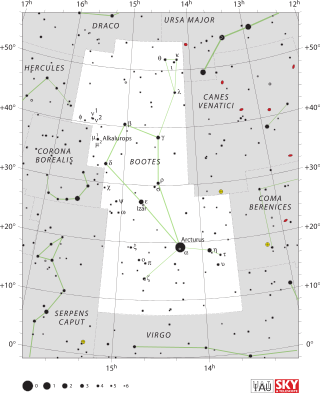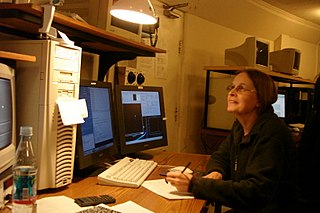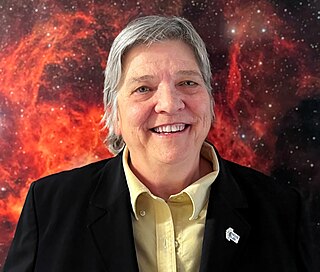
The Kitt Peak National Observatory (KPNO) is a United States astronomical observatory located on Kitt Peak of the Quinlan Mountains in the Arizona-Sonoran Desert on the Tohono Oʼodham Nation, 88 kilometers (55 mi) west-southwest of Tucson, Arizona. With more than twenty optical and two radio telescopes, it is one of the largest gatherings of astronomical instruments in the Earth's northern hemisphere.

A star is a luminous spheroid of plasma held together by self-gravity. The nearest star to Earth is the Sun. Many other stars are visible to the naked eye at night; their immense distances from Earth make them appear as fixed points of light. The most prominent stars have been categorised into constellations and asterisms, and many of the brightest stars have proper names. Astronomers have assembled star catalogues that identify the known stars and provide standardized stellar designations. The observable universe contains an estimated 1022 to 1024 stars. Only about 4,000 of these stars are visible to the naked eye—all within the Milky Way galaxy.

70 Virginis is a binary star located 59 light years from the Sun in the equatorial constellation of Virgo, near the northern constellation border with Coma Berenices. 70 Virginis is its Flamsteed designation. The star is visible to the naked eye as a faint, yellow-hued point of light with an apparent visual magnitude of +4.97. It is drifting further away with a heliocentric radial velocity of +4.4 km/s and has a high proper motion, traversing the celestial sphere at the rate of 0.621 arc seconds per annum.

The National Optical Astronomy Observatory (NOAO) was the United States national observatory for ground-based nighttime ultraviolet-optical-infrared (OUVIR) astronomy. The National Science Foundation (NSF) funded NOAO to provide forefront astronomical research facilities for US astronomers. Professional astronomers from any country in the world could apply to use the telescopes operated by NOAO under the NSF's "open skies" policy.

The Cerro Tololo Inter-American Observatory (CTIO) is an astronomical observatory located on the summit of Mt. Cerro Tololo in the Coquimbo Region of northern Chile, with additional facilities located on Mt. Cerro Pachón about 10 kilometres (6.2 mi) to the southeast. It is approximately 80 kilometres (50 mi) east of La Serena, where support facilities are located. The principal telescopes at CTIO are the 4 m Víctor M. Blanco Telescope, named after Puerto Rican astronomer Víctor Manuel Blanco, and the 4.1 m Southern Astrophysical Research Telescope, which is situated on Cerro Pachón. Other telescopes on Cerro Tololo include the 1.5 m, 1.3 m, 1.0 m, and 0.9 m telescopes operated by the SMARTS consortium. CTIO also hosts other research projects, such as PROMPT, WHAM, and LCOGTN, providing a platform for access to the southern hemisphere for U.S. and worldwide scientific research.

Gamma Virginis, officially named Porrima, is a binary star system in the constellation of Virgo. It consists of two almost identical main sequence stars at a distance of about 38 light-years.

Eta Virginis is a triple star system in the zodiac constellation of Virgo. From parallax measurements, it is about 246 light-years from the Sun. It has a combined apparent visual magnitude of 3.89, bright enough to be seen with the naked eye in dark skies.

Tau Tauri, Latinized from τ Tauri, is a quadruple star system in the constellation Taurus. It is visible to the naked eye as a faint point of light with a combined apparent visual magnitude of 4.33. The distance to this system is approximately about 400 light years based on parallax. The system is moving further from the Earth with a heliocentric radial velocity of +14.6 km/s, and it is a member of the Taurion OB association, located between Orion and Taurus. It is located 0.7 degree north of the ecliptic, and thus is subject to lunar occultations.

Zeta Boötis, Latinized from ζ Boötis, is a binary star system in the constellation of Boötes. They have the Flamsteed designation 30 Boötis; Zeta Boötis is the Bayer designation. This system is visible to the naked eye with a combined apparent magnitude of +3.78. The individual magnitudes differ slightly, with component A having a magnitude of 4.46 and component B at the slightly dimmer magnitude 4.55. It is located at a distance of approximately 180 light years from the Sun based on parallax, but is drifting closer with a radial velocity of −9 km/s.
9423 Abt, provisional designation 1996 AT7, is a stony background asteroid from the central region of the asteroid belt, approximately 13 kilometers in diameter. It was discovered on 12 January 1996, by the Spacewatch project of the University of Arizona at Kitt Peak National Observatory, United States. The asteroid was named after American astronomer Helmut Abt.

Nicholas Ulrich Mayall was an American observational astronomer. After obtaining his doctorate from the University of California, Berkeley, Mayall worked at the Lick Observatory, where he remained from 1934 to 1960, except for a brief period at MIT's Radiation Laboratory during World War II.

Upsilon Ophiuchi is a triple star system in the equatorial constellation of Ophiuchus. It has a white hue and is faintly visible to the naked eye with an apparent visual magnitude of 4.62. The distance to this system is approximately 134 light years based on parallax. It is drifting closer with a radial velocity of −30.6 km/s.

Mercedes Tharam Richards, née Davis, was a Jamaican astronomy and astrophysics professor. Her investigation focused on computational astrophysics, stellar astrophysics and exoplanets and brown dwarfs, and the physical dynamics of interacting binary stars systems. However, her pioneering research in the tomography of interacting binary star systems and cataclysmic variable stars to predict magnetic activity and simulate gas flow is her most known work.

Jorge Sahade was an Argentine astronomer with more than 200 publications in journals and conferences. He was the first Latin American to achieve the presidency of the International Astronomical Union (IAU) between 1985 and 1988, and was also the first director of the Comisión Nacional de Actividades Espaciales. He held this position between 1991 and 1994.

Sidney Carne Wolff is an American astrophysicist, researcher, public educator, and author. She is the first woman in the United States to head a major observatory, and she provided significant contributions to the construction of six telescopes. Wolff served as Director of the Kitt Peak National Observatory (KPNO) and the National Optical Astronomy Observatory (NOAO). She is a member of the International Astronomical Union's Division G: Stars and Stellar Physics.

Petr Horálek is a Czech astrophotographer, popularizer of astronomy and an artist.

Nidia Irene Morrell is an Argentine astronomer who is a permanent staff member at the Las Campanas Observatory in La Serena, Chile. She was a member of the Massive Stars research group led by Virpi Niemelä and the Hubble Heritage Project. Professionally, she is known for her numerous contributions related to the astrophysics of massive stars. She participates in the systematic search for variations of brightness in stellar objects, including the observation of a candidate for the Thorne–Żytkow object. She was also a member of the team that discovered the supernova ASASSN-15lh.

NSF’s NOIRLab is a United States federally funded research and development center for ground-based, nighttime optical and infrared astronomy.

BH Virginis is a binary star system in the equatorial constellation of Virgo. With a typical apparent visual magnitude of 9.6, it is too faint to be visible to the naked eye. Based on parallax measurements, it is located at a distance of approximately 488 light years from the Sun. The system is drifting closer with a net radial velocity of −23 km/s.

Lori Elaine Allen is an American astronomer, the director of Mid-Scale Observatories at NOIRLab, a center for ground-based optical and infrared astronomy funded by the National Science Foundation that operates several astronomy facilities worldwide.


















